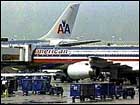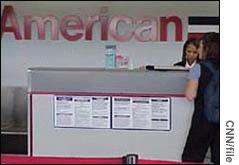|
Travel recovery grounded
|
 |
November 8, 2001: 4:00 p.m. ET
Airlines, travel industry still hurting from lack of business in attack's wake.
By Staff Writer Chris Isidore
|
NEW YORK (CNNmoney) - Some analysts have a stark and bleak prediction as to when the U.S. airline industry will be able to return to pre-Sept. 11 levels.
"Never," said Robert Fenimore, senior partner with consultant KPMG LLP, overseeing the firm's airline practice.
"I think there will be a permanent decline in air travel," said Fenimore. "I think there's a certain amount of discretionary travel that was done before the attack that will not come back."
Ray Neidl, analyst with ABN Amro, also believes that travel patterns may be forever changed by the attack.
"Things will return to somewhat normal in second half of next year," Neidl predicted. "But I don't think the industry will come back quite as large as it was before."
The attack was so unprecedented that predicting when air travelers will return has been a difficult endeavor. So far most predictions, as bleak as they have been, have been overly optimistic.
Most major airlines cut their schedules and staff by about 20 percent in the wake of the attack, reducing their capacity to fly passengers by 16 percent. But the October traffic numbers from the Air Transport Association show the miles flown by paying customers are down 25 percent, despite deeply discounted fares.
That means that revenues will be particularly hard hit since the average paid per mile flown could be down another 25 to 30 percent in the face of sales announced after the attack.
Other costs, including advertising and insurance have also soared for the carriers. But they have seen fuel prices fall, giving them a break in their second greatest expense after labor.
Airlines have been bleak in their financial outlook. James Goodwin, the CEO of United Airlines owner UAL Corp., lost his job after he wrote a letter to employees saying the airline is hemorrhaging money and that the future of the airline was in doubt. Other executives warned of widespread bankruptcies without federal assistance.
In response, Congress approved $5 billion of direct aid and another $10 billion of loan guarantees. The airlines received about half of that money just before the end of September, and are awaiting the second half of the payments. Those problems lifted the threat of immediate bankruptcy filings but it won't be enough if air travel doesn't show more signs of a come back, according to analysts.
"I think what that (federal assistance) has done is not eliminate the liquidity crisis but deferred it," said Fenimore. "If in fact there's recovery, then it's possible the liquidity will not become a severe problem. If there is no recovery in travel, when we get to the first of the year, the liquidity crisis could be serious again."
| |

|
|
If more travelers don't return to the air, analysts worry cost cutting won't be enough to stem losses in the industry. | |
While many carriers came in with third-quarter losses a bit smaller than forecasts, analysts believe the nation's eight largest carriers will all report larger losses in the fourth quarter. Even Southwest Airlines (LUV: Research, Estimates) , the industry's most profitable carrier, is now expected to be in the red in the quarter.
An additional round of schedule cutbacks and staff cuts are probably looming if the holiday season doesn't see a pickup in travel, said Fenimore. The new UAL Corp. CEO says the employee-owned company is talking to unions about concessions. But even new labor contracts and the lower fuel prices the industry is enjoying are not enough by themselves, Fenimore warned.
"If there's nobody on the plane, it doesn't matter what your cost is," he said. "An airline is a fixed cost operation."
It's difficult to assess how much of the downturn in air travel is due to passenger fear of flying and how much is due to the economic slowdown cutting the money available for both business and personal travel. But the lack of pickup in the face of deep air fare sales suggests that price and the economy are not the main problems. Neidl said that because of that, some carriers may let fare sales end and ticket prices rise in an effort to gather more revenue from those willing to fly again.
Last summer the Justice Department blocked a purchase of US Airways Group, the No. 6 airline, by UAL, citing fears of anti-competitive impact of such a combination. Those fears would likely be overridden now by concerns over the financial health of the industry, clearing the way for easier deal approval, said Fenimore. But he also doesn't believe any of the players have the resources now to pull off such a deal.
"The companies have to get cleaned up, restructured," he said. "The merger activity may not be in next 90 days, but 9 months to 24 months, once people have confidence about what is going to happen, we could see it again."
Click here for a look at airline stocks
Of course the drop in air travel is affecting a broad range of other industries, from hotels to car rental agencies theme parks. None of them are looking for immediate uptick.
Statistics from these other industries are not as readily compiled as the air traffic numbers, although data from Smith Travel Research, which compiles rates and occupancy information from a majority of the nation's hotels, shows that hotel use remains more than 10 percent below year-ago levels eight weeks after the attack, after a roughly 20 percent decline in occupancy in the two weeks immediately following the attack.
Occupancy at airport hotels remained down 14.6 percent in the week ending Nov. 3, while it was off 18.2 percent at resorts, suggesting leisure travel is still particularly weak.
And as in the case of airline industry, hotels have cut rates in a bid to fill empty capacity. For the most recent week average hotel rates were off about 8 percent from year ago levels nationwide. The upscale chains have cut rates the most, down 11.6 percent, while economy chains have reduced prices only 2.5 percent.
"It's obviously going to take some time for people to return to normal travel patterns," said Brad Garner of Smith Travel Research. "Even before the attacks, you're talking about an industry being challenged." 
|
|
|
|
|
|

|

